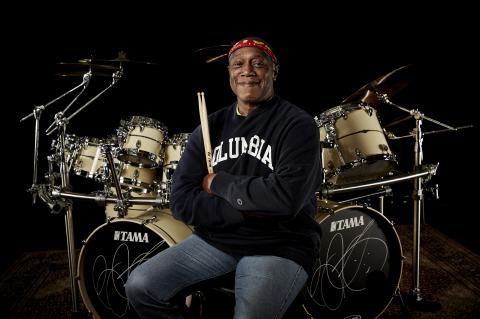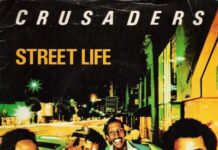Photo Courtesy of Billy Cobham
Billy Cobham
Spectrum
Billy Cobham became a legend well before releasing his debut solo album. Prior to 1973, the Panamanian drummer by way of New York cut his teeth — and worked his sticks into overdrive — backing jazz luminaries like George Benson, Kenny Burrell, and Ron Carter in the studio. And let’s not forget his serving as primary percussionist and the backbone of the jazz-rock group Dreams, Miles Davis’ seminal Jack Johnson fusion album, and the Mahavishnu Orchestra’s mind-blowing The Inner Mounting Flame and Birds Of Fire.
Yet, in 1973, Cobham, then not even 30, found himself at an interesting musical crossroads, especially as Mahavishnu’s first lineup ceased to be.
“When I found out that the (Mahavishnu Orchestra) was going to change personnel, and that I would be replaced, I figured it was paramount that I create a platform for myself from which I could continue to be effective on all levels as an artist,” Cobham, now 74, told me recently via email. “I began to canvas interest from musicians whom I had developed a good level of respect for their musical abilities and whom, in return, respected me for what I had accomplished at that time as a musician.”
By the time Cobham began ramping up for Spectrum, his first solo album, Birds Of Fire had been in stores for less than two months. Securing quick interest in his project from Atlantic Records, Cobham then worked to assemble a stellar backing crew of players to better flesh out his creative output as leader.
For Cobham, the objective was to find players he felt “kindred ties” to, ones who were seemingly already successful or poised for their own individual superstar status. These included Mahavishnu band mate Jan Hammer on keyboards, saxophonist Joe Farrell, bassist Leland Sklar (James Taylor), and arguably the most influential artist in helping send Cobham into the musical stratosphere — guitar virtuoso Tommy Bolin (of Zephyr and eventual Deep Purple fame).

Though Bolin would release two solo albums in his own lifetime, Spectrum serves as the best introduction to his talents — at his peak musically and barely out of his teens.
“Tommy Bolin played like a 50-year-old, well-seasoned and traveled musician with much history to share in every note,” Cobham told me. “I felt that no one would have guessed that he was not far from about 19 years old when he supported me on that record.”
Instead of relying on volume and flash on Spectrum compared to his earlier work with Miles Davis and John McLaughlin, Cobham and his crew set about distancing themselves from the Mahavishnu sound; focusing instead on groove and emotion to make their musical point.
“I chose to travel a parallel path to success in terms of what I presented to the public by reflecting only so much upon the way that I performed with the Mahavishnu Orchestra,” Cobham told me, “I felt that presenting music that mimicked that platform would not be well-received by the general public. I was right.”
Spectrum kicks off with the maniacally fast-paced “Quadrant 4” as Bolin and Hammer eagerly keep up with Cobham’s cymbal and snare-driven tones until the groove shifts about a minute in. From there, you’re treated to a pure classic of the jazz fusion genre. Imagine Sun Ra on speed or Funkadelic playing with total instrumental cohesion — that’s what you get on this track. Yet while listeners unfamiliar with the album are sure to be enthralled by this, “Taurian Matador” and the album’s title track, Cobham switches gears on us throughout by making sure to preface several songs with slower and easier-to-digest musical vignettes. While it’s easy to think this album is dominated by complexity, this was not a quality Cobham intentionally strove for while recording the album.
“What saved the day for me was ‘Stratus’ and ‘Red Baron’ because they sustained a groove that was not expected by the public, yet was very much accepted for their musicality and level of challenge to all who chose to play them,” Cobham said.
 Photo Courtesy of Billy Cobham
Photo Courtesy of Billy Cobham
Initially unaware of Cobham’s professionalism, I soon learned the album was rehearsed by all players first before being recorded at the famed Electric Lady Studios in only three days.
“Knowing who would perform that music was pivotal to spending quality time in the studio,” Cobham said. “While we were there, it was all business, yet very enjoyable because we all wanted to achieve the same thing … I was honored and fortunate to have had access to these ‘great minds’ for that project.”
Released during the height of progressive rock, the apex of glam, and the early rumblings of punk, Spectrum would not only top the Billboard Jazz Albums chart but also climb into the Top 30 of the Billboard 200, a feat easily rivaling that of Mahavishnu version one.
Cobham would go on to keep innovating his jazz discography over the years, playing with everyone from the Brecker Brothers, to Stanley Clarke, to the late George Duke. As a companion piece to Spectrum, consider checking out two mid-1970s albums by the revamped Tony Williams Lifetime — Believe It and Million Dollar Legs — featuring Allan Holdsworth on lead guitar. You’ll hear Cobham’s (unintentional) Spectrum influence throughout both.
Masterpieces in music aren’t achieved often. While I’m sure to be criticized for applying the term to Cobham’s debut, there is no denying the prowess and genuine talent that permeates throughout its collective structure. Funnily enough, ask the man himself what he hoped to achieve with the album and you’ll get an unexpected answer:
“My objective was to make a recording that I could present to local promoters to consider hiring me and my band — if I ever got that far — to play in their venues. What came out of all of that still surprises me to this day.”
***
Share your feedback and suggestions for future columns with Ira at vinylconfessions84@gmail.com.




















